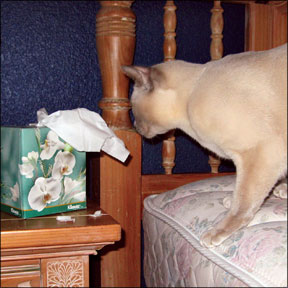We all recognize scratching as a normal behavior for a cat. Should your cat claw his way into the arm of your favorite chair, you would simply let out a sigh of regret, and wonder why you hadnt thought to cover that precious piece of furniture. 288 Somehow, people feel quite differently when instead of scratching, their cat chews their furniture or their clothing, or any other item, for that matter. Why is that? Isnt chewing normal? In fact, some chewing, although destructive, may be normal. Cats are not equipped to do much grinding of food. But they are curious creatures. When a curious creature needs information about something in his environment, he employs any one or more of the senses he has available. As such, all animals are prone to using their mouths to examine items. Sometimes, in the course of manipulating an item, the item may even be swallowed. So is this normal? That is, if you come home to find your new cherry armoire has been fatally marred by tooth marks, should your cat be seen by a behaviorist? The answer is maybe. As I suggested, some chewing of nonfood items may be part of normal exploratory behavior. If you discover an occasional tooth mark on furniture, your cat is probably quite normal. You may perform a simple diagnostic test: Leave interesting and appropriate cat toys near your armoire. If the toys are scattered about and the armoire unscathed, then your cat is behaviorally healthy. The treatment? Be sure that the environment is always stimulating. Leave plenty of interactive toys in various areas of the house. And, of course, you should protect your most valuable furniture or items. There is another reason that normal cats begin to chew inappropriate items: The behavior garners them attention. Granted, they may have to endure a few moments of scolding, but the net result is still pleasant. Hence the term “attention-seeking behavior.” Be careful not to fall into that trap! Distract your cat, or startle him but dont offer him attention until he has begun to play with his own toys. Normal cats tend to chew items on an occasional basis. The cat that consistently reaches for nonfood items, whether or not his family is nearby, may not be normal at all. Worse still, some cats actually ingest the items that they have chewed. The term “pica” is used to describe the ingestion of nonfood items. The first consideration when a cat begins to chew or eat nonfood items is that he might not be healthy. Be particularly concerned when a mature cat suddenly develops a change in his pattern of chewing or eating. Have your veterinarian check your cats teeth, gums and throat carefully. Be sure your cat is able to digest the food that you give him, and that he is not suffering from a form of malnutrition. Some lab work might also be indicated based on the physical findings. If no physical cause of the behavior is determined, then we must consider a primary behavioral abnormality. Indeed, eating disorders often reflect a compulsive disorder. Some behaviorists use the term obsessive-compulsive disorder (OCD). That is, cats are so attracted to certain items that they seem to be obsessed by them. Why would a cat develop this type of behavior? In some cases, there may be a genetic predisposition. For example, Oriental breeds of cats chew or ingest fabric more than other breeds of cats. Anxiety and OCD OCD is generally considered to be an anxiety-based behavior. Cats may chew or ingest items as a way to comfort themselves. Anxious cats may also explore the environment with a greater intensity than normal cats. Rather than casually batting an item, they may use both their paws and mouths to investigate. A diagnosis of OCD is usually given to a cat that spends an inordinate amount of his time engaging in chewing behavior. Affected cats are often difficult to distract. They work very hard to find their desired targets. They may even distance themselves socially. Luckily, treatment is available. There are behavior-modification techniques to help cats relax. The environment may be modified as needed to assure an appropriate level of stimulation and to prevent your cat from injuring himself. For some cats, psychotropic medication will reduce the intensity of the behavior. If you suspect OCD, dont delay in seeking a diagnosis and treatment. The longer to the delay in treating this condition, the harder it can be to control. 



